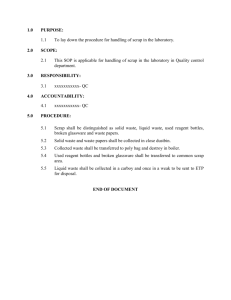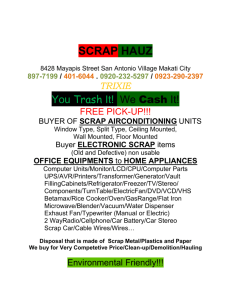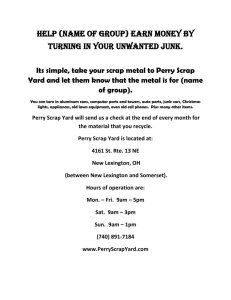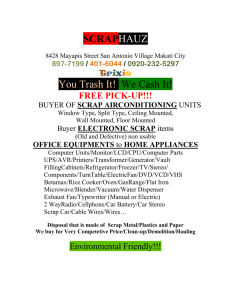doc
advertisement
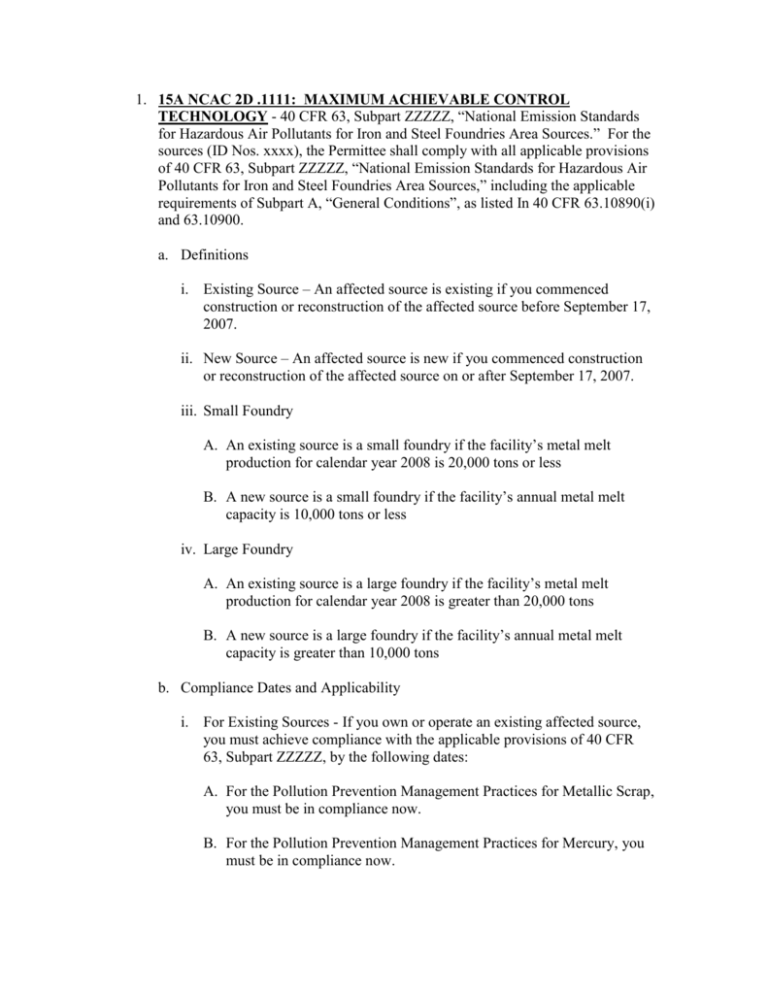
1. 15A NCAC 2D .1111: MAXIMUM ACHIEVABLE CONTROL TECHNOLOGY - 40 CFR 63, Subpart ZZZZZ, “National Emission Standards for Hazardous Air Pollutants for Iron and Steel Foundries Area Sources.” For the sources (ID Nos. xxxx), the Permittee shall comply with all applicable provisions of 40 CFR 63, Subpart ZZZZZ, “National Emission Standards for Hazardous Air Pollutants for Iron and Steel Foundries Area Sources,” including the applicable requirements of Subpart A, “General Conditions”, as listed In 40 CFR 63.10890(i) and 63.10900. a. Definitions i. Existing Source – An affected source is existing if you commenced construction or reconstruction of the affected source before September 17, 2007. ii. New Source – An affected source is new if you commenced construction or reconstruction of the affected source on or after September 17, 2007. iii. Small Foundry A. An existing source is a small foundry if the facility’s metal melt production for calendar year 2008 is 20,000 tons or less B. A new source is a small foundry if the facility’s annual metal melt capacity is 10,000 tons or less iv. Large Foundry A. An existing source is a large foundry if the facility’s metal melt production for calendar year 2008 is greater than 20,000 tons B. A new source is a large foundry if the facility’s annual metal melt capacity is greater than 10,000 tons b. Compliance Dates and Applicability i. For Existing Sources - If you own or operate an existing affected source, you must achieve compliance with the applicable provisions of 40 CFR 63, Subpart ZZZZZ, by the following dates: A. For the Pollution Prevention Management Practices for Metallic Scrap, you must be in compliance now. B. For the Pollution Prevention Management Practices for Mercury, you must be in compliance now. C. Not later than 2 years after the date of your large foundry’s notification of the initial determination required in 40 CFR 63.10880(f) for the Standards and Management Practices for large foundries required in 40 CFR 63.10895 ii. For New Sources – If you own or operate a new affected source, your must achieve compliance with the applicable provisions of 40 CFR 63, Subpart ZZZZZ upon startup. iii. For New Sources, you must determine the initial applicability of the requirements of this subpart to a small foundry or a large foundry based on your facility’s annual metal melting capacity at startup. If the annual metal melting capacity is 10,000 tons or less, your area source is a small foundry. If the annual metal melting capacity is greater than 10,000 tons, your area source is a large foundry. You must submit a written notification to the Administrator that identifies your area source as a small foundry or a large foundry no later than 120 days after startup. c. Size Reclassification – For small foundries which exceed the metal melt production as listed in the definitions above, or for large foundries which drop below the metal melt production as listed in the definitions above, you must comply with the requirements of 40 CFR 63.10881(d) and (e), as applicable, including notifications of reclassification as required. d. Pollution Prevention Management Practices for New and Existing Affected Sources i. Metallic Scrap Management Program – For each segregated metallic scrap storage area, bin or pile, you must comply with the materials acquisition requirements below in paragraph (d)(i)(A) or (B). You must keep a copy of the material specifications onsite and readily available to all personnel with material acquisition duties, and provide a copy to each of your scrap providers. You may have certain scrap subject to paragraph (a)(i)(A) of this section and other scrap subject to paragraph (a)(ii) of this section at your facility provided the metallic scrap remains segregated until charge make-up. A. Restricted metallic scrap. You must prepare and operate at all times according to written material specifications for the purchase and use of only metal ingots, pig iron, slitter, or other materials that do not include post-consumer automotive body scrap, post-consumer engine blocks, post-consumer oil filters, oily turnings, lead components, chlorinated plastics, or free liquids, per 40 CFR 63.10885(a)(i) B. General iron and steel scrap. You must prepare and operate at all times according to written material specifications for the purchase and use of only iron and steel scrap that has been depleted (to the extent practicable) of organics and HAP metals in the charge materials used by the iron and steel foundry. The material specifications must include at minimum the information specified in 40 CFR 63.10885(a)(2)(i) and (ii) ii. Mercury requirements. For scrap containing motor vehicle scrap, you must procure the scrap pursuant to one of the compliance options as listed in 40 CFR 63.10885(b)(1), (2), or (3) for each scrap provider, contract, or shipment. For scrap that does not contain motor vehicle scrap, you must procure the scrap pursuant to the requirements in 40 CFR 63.10885(b)(4) for each scrap provider, contract, or shipment. You may have one scrap provider, contract, or shipment subject to one compliance provision and others subject to another compliance provision. The compliance options are as follows: A. Site-specific plan for mercury switches. You must have an Administrator approved plan and submit semiannual progress reports for each scrap supplier. You must maintain records per the requirements of 40 CFR 63.10890(e)(3); B. Option for approved mercury programs You must certify in your notification of compliance status that you purchase motor vehicle scrap only from providers who participate in an approved mercury switch removal program; or C. Option for specialty metal scrap You must certify in your notification of compliance status and maintain records of documentation that the scrap material is not reasonably expected to contain mercury switches; D. Scrap that does not contain motor vehicle scrap. For scrap not subject to the requirements in paragraph (d)(ii)(A) through (C) above, you must certify in your notification of compliance status and maintain records of documentation that this scrap does not contain motor vehicle scrap. e. Management practices for binder formulations. For each furfuryl alcohol warm box mold or core making line at a new or existing iron and steel foundry, you must use a binder chemical formulation that does not use methanol as a specific ingredient of the catalyst formulation. This requirement does not apply to the resin portion of the binder system. f. Requirements for New and Existing Affected Sources Classified as Small Foundries i. Management Practices Requirements A. You must comply with the pollution prevention management practices for metallic scrap and mercury switches in paragraph (d)(i) and (ii) above B. You must comply with the management practices for binder formulations in paragraph (e) above. C. Following the initial determination for an existing affected source as a small foundry, if the annual metal melt production exceeds 20,000 tons during the preceding year, you must comply with the requirements for large foundries by the applicable dates in paragraph (b) above D. Following the initial determination for a new affected source as a small foundry, if you increase the annual metal melt capacity to exceed 10,000 tons during the preceding year, you must comply with the requirements for large foundries by the applicable dates in paragraph (b) above ii. Recordkeeping Requirements. The facility must maintain records as follows: A. Maintain files of all information (including all reports and notifications) for at least 5 years following the date of each occurrence, measurement, maintenance, corrective action, report, or record. At a minimum, the most recent 2 years of data shall be retained on site. The remaining 3 years of data may be retained off site. The files may be either written or electronic. B. Maintain records supporting your initial notification of applicability and your notification of compliance status according to 40 CFR 63.10(b)(2)(iv) C. Maintain records of your written materials specifications according to paragraph (d)(i) and records that demonstrate compliance with the requirements for restricted metallic scrap in paragraph (d)(i)(A) and/or for the use of general scrap in paragraph (d)(i)(B) and for mercury in paragraph (d)(ii)(A) through (C) D. Maintain records documenting compliance with the requirements for scrap that does not contain motor vehicle scrap in paragraph (d)(ii)(D) E. If you are subject to the requirements for a site-specific plan for mercury switch removal under 40 CFR 63.10885(b)(1), records of the number of mercury switches removed or the weight of mercury recovered from the switches and properly managed, the estimated number of vehicles processed, and an estimate of the percent of mercury switches recovered F. If you are subject to the option for approved mercury programs under 40 CFR 63.10885(b)(2), records identifying each scrap provider and documenting the scrap provider’s participation in an approved mercury switch removal program. If you purchase motor vehicle scrap from a broker, you must maintain records identifying each broker and documentation that all scrap provided by the broker was obtained from other scrap providers who participate in an approved mercury switch removal program. G. Maintain records to document use of binder chemical formulation that does not contain methanol as a specific ingredient of the catalyst formulation as required in paragraph (e) above. These records must be the Material Safety Data Sheet (provided that it contains appropriate information), a certified product data sheet, or a manufacturer’s hazardous air pollutant data sheet. H. Maintain records of the annual quantity and composition of each HAPcontaining chemical binder or coating material used to make molds and cores. These records must be copies of purchasing records, Material Safety Data Sheets, or other documentation that provides information on the binder or coating materials used. I. Maintain records of monthly metal melt production for each calendar year iii. Reporting Requirements. The facility must submit the following: A. An initial notification of applicability according to 40 CFR 63.9(b)(2) B. A notification of compliance status according to 40 CFR 63.9(h)(1)(i). You must send the notification of compliance status within 30 days after the applicable compliance date specified in paragraph (b) above. See 40 CFR 63.10890(c)(1) through (3) for compliance certification language. C. If you are subject to the requirements for a site-specific plan for mercury switch removal under 40 CFR 63.10885(b)(1), you must submit semiannual reports as required under 40 CFR 63.10890(e)(3)(ii) D. Semiannual compliance reports according to the requirements of 40 CFR 63.10(e). The report must clearly identify any deviation from the pollution prevention management practices in paragraphs (d) and (e) above E. Notification of any reclassification of an affected source as large foundry per paragraph (f)(i)(C) or (D) above g. Requirements for New and Existing Affected Sources Classified as Large Iron and Steel Foundries i. Management Practices, Monitoring, and Inspection & Maintenance Requirements A. Comply with the pollution prevention management practices for metallic scrap and mercury switches in paragraph (d)(2) above B. Comply with the management practices for binder formulations in paragraph (e) above. C. Operate a capture and collection system for each metal melting furnace at a new or existing iron and steel foundry unless that furnace is specifically uncontrolled as part of an emissions averaging group. D. If you own or operate a new affected source, comply with each control device parameter operating limit as follows: I. For each wet scrubber, maintain the 3-hour average pressure drop and scrubber water flow rate at or above the minimum levels established during the initial or subsequent performance test. II. For each electrostatic precipitator, maintain the voltage and secondary current (or total power input) to the control device at or above the level established during the initial or subsequent performance test. E. Prepare and operate at all times according to a written operation and maintenance (O & M) plan for each control device for an emissions source subject to a PM, metal HAP, or opacity emissions limit. Maintain a copy of the O & M plan at the facility and make it available for review upon request. The plan must contain information as specified in 40 CFR 63.10896. F. Conduct an initial inspection of each PM control device, per the requirements of 40 CFR 63.10897(a)(1) through (4). The initial inspection must be conducted no later than 60 days after your applicable compliance date, or upon startup if the control device has not been operated within 60 days of the compliance date. G. Conduct periodic inspections of each PM control device. I. For Baghouses a. Conduct monthly visual inspection of the system ductwork for leaks b. Conduct interior inspection of the baghouse for structural integrity and to determine the condition of the fabric filter every 6 months c. For existing affected sources, you may install, operate, and maintain a bag leak detection system as an alternative to the monthly and 6 month inspection requirements. See 40 CFR 63.10897(d)(1) through (3) for requirements for this bag leak detection system. d. For new affected sources, you must install, operate, and maintain a bag leak detection system for each negative pressure baghouse or positive pressure baghouse. You must install, operate, and maintain each bag leak detection system according to the requirements in 40 CFR 63.10897(d)(1) through (3). II. For Dry Electrostatic Precipitators a. Conduct a daily inspection to verify the proper functioning of the electronic controls for corona power and rapper operation, that the corona wires are energized, and that adequate air pressure is present on the rapper manifold. b. Conduct monthly visual inspections of the system ductwork, housing unit, and hopper for leaks c. Conduct inspections of the interior of the precipitator every 24 months to determine the condition and integrity of corona wires, collection plates, plate rapper, hopper, and air diffuser plates. d. For each electrostatic precipitator applied to emissions from a metal melting furnace at a new affected source, you must measure and record the hourly average voltage and secondary current (or total power input) using a CPMS. III. For Wet Electrostatic Precipitators a. Conduct a daily inspection to verify the proper functioning of the electronic controls for corona power, that the corona wires are energized, and that water flow is present b. Conduct monthly visual inspections of the system ductwork, electrostatic precipitator housing unit, and hopper for leaks c. Conduct inspections of the interior of the precipitator every 24 months to determine the condition and integrity of corona wires, collection plates, plate wash spray heads, hopper, and air diffuser plates. d. For each electrostatic precipitator applied to emissions from a metal melting furnace at a new affected source, you must measure and record the hourly average voltage and secondary current (or total power input) using a CPMS. IV. For Wet Scrubbers a. Conduct a daily inspection to verify the presence of water flow to the scrubber b. Conduct monthly visual inspections of the system ductwork and scrubber unit for leaks c. Conduct inspections of the interior of the scrubber every 12 months to determine the structural integrity and condition of the demister and spray nozzle. d. For each wet scrubber applied to emissions from a metal melting furnace at a new affected source, you must use a continuous parameter monitoring system (CPMS) to measure and record the 3-hour average pressure drop and scrubber water flow rate. H. Make monthly inspections of the equipment that is important to the performance of the total capture system (i.e. pressure sensors, dampers, and damper switches). You must repair any defect or deficiency in the capture system as soon as practicable, but no later than 90 days. I. Install, operate, and maintain each Continuous Parameter Monitoring System (CPMS) or other measurement device according to your O & M plan. J. In the event of an exceedance of an established emissions limitation (including an operating limit), you must restore operation of the emissions source (including the control device and associated capture system) to its normal or usual manner of operation as expeditiously as practicable. ii. Recordkeeping Requirements A. Maintain files of all information (including all reports and notifications) for at least 5 years following the date of each occurrence, measurement, maintenance, corrective action, report, or record. At a minimum, the most recent 2 years of data shall be retained on site. The remaining 3 years of data may be retained off site. The files may be either written or electronic. The records must be made available to DAQ personnel upon request. B. Maintain records of your written materials specifications according to paragraph (d)(i) and records that demonstrate compliance with the requirements for restricted metallic scrap in paragraph (d)(i)(A) and/or for the use of general scrap in paragraph (d)(i)(B) and for mercury in paragraphs (d)(ii)(A) through (C) C. Maintain records documenting compliance with the requirements for scrap that does not contain motor vehicle scrap in paragraph (d)(ii)(D) D. If you are subject to the requirements for a site-specific plan for mercury switch removal under 40 CFR 63.10885(b)(1), records of the number of mercury switches removed or the weight of mercury recovered from the switches and properly managed, the estimated number of vehicles processed, and an estimate of the percent of mercury switches recovered E. If you are subject to the option for approved mercury programs under 40 CFR 63.10885(b)(2), records identifying each scrap provider and documenting the scrap provider’s participation in an approved mercury switch removal program. If your scrap provider is a broker, you must maintain records identifying each of the broker’s scrap suppliers and documenting the scrap supplier’s participation in an approved mercury switch removal program. F. Maintain records to document use of any binder chemical formulation that does not contain methanol as a specific ingredient of the catalyst formulation for each furfuryl alcohol warm box mold or core making line as required in paragraph (e) above. These records must be the Material Safety Data Sheet (provided that it contains appropriate information), a certified product data sheet, or a manufacturer’s hazardous air pollutant data sheet. G. Maintain records of the annual quantity and composition of each HAPcontaining chemical binder or coating material used to make molds and cores. These records must be copies of purchasing records, Material Safety Data Sheets, or other documentation that provides information on the binder or coating materials used. H. Maintain records of monthly metal melt production for each calendar year. I. Maintain a copy of the operation and maintenance plan as required by 40 CFR 63.10896(a) and records that demonstrate compliance with plan requirements. J. If applicable, maintain records for bag leak detection systems per the requirements of 40 CFR 63.10899(b)(9). K. Maintain records of capture system inspections and repairs as required by 40 CFR 63.10897(e). L. Record the results of each initial and periodic inspection and any maintenance action in a logbook (written or electronic). M. Record all information needed to document conformance to the O & M plan for each CPMS or other measurement device. N. Record the date and time correction action was initiated in response to an exceedance of an emissions limitation, the correction action taken, and the date corrective action was completed. O. If you choose to comply with an emissions limit using emissions averaging, you must calculate and record for each calendar month the pounds of PM or total metal HAP per ton of metal melted. iii. Performance Testing Requirements A. You must conduct a performance test per the requirements of 40 CFR 63.10898 to demonstrate initial compliance with the applicable emissions limits for each metal melting furnace or group of all metal melting furnaces that is subject to an emissions limit as listed below and for each building or structure housing foundry operations that is subject to the opacity limit for fugitive emissions as listed below. The initial performance test must be conducted within 180 days of your compliance date. B. Conduct subsequent performance tests no less frequently than every 5 years for PM and total metal HAP emissions and no less frequently than every 6 months for opacity tests for fugitive emissions and each time you elect to change an operating limit or make a process change likely to increase HAP emissions or fugitive emissions, per the requirements of 40 CFR 63.10898. iv. Reporting Requirements A. Submit semiannual compliance reports according to the requirements in 40 CFR 63.10(e). The reports must include, at a minimum, the following information as applicable: a. Summary information on the number, duration, and cause (including unknown cause, if applicable) of excursions or exceedances, as applicable, and the corrective action. b. Summary information on the number, duration, and cause (including unknown cause, if applicable) for monitor downtime incidents (other than downtime associated with zero and span or other calibration checks, if applicable). c. Summary information on any deviation from the pollution prevention management practices (PPMP) and the operation and maintenance requirements and the corrective action taken. d. Results of your initial compliance performance test, per the requirements of 40 CFR 63.10898(a) B. If you are subject to the requirements for a site-specific plan for mercury under 40 CFR 63.10885(b)(1), you must submit semiannual reports are required under 40 CFR 63.10899(b)(2)(ii) v. Emissions Limitation. Emissions from a metal melting furnace or group of all metal melting furnaces must not exceed the following applicable limits Source Existing Foundry New Foundry Emission Limits 0.8 lb PM/ton of metal charged 0.06 lb Total Metal HAP/ton of metal charged Fugitive Emissions <20% Opacity 0.1 lb PM/ton of metal charged 0.008 lb Total Metal HAP/ton of metal charged Fugitive Emissions <20% Opacity For a new or existing iron and steel foundry, fugitive emissions from foundry operations must not exceed an opacity greater than 20 percent (6minute average), except for one 6-minute average per hour that does not exceed 30 percent. In the event of an exceedance of an established emissions limitation (including an operating limit), you must restore operation of the emissions source (including the control device and associated capture system) to its normal or usual manner of operation as expeditiously as practicable in accordance with good air pollution control practices for minimizing emissions. The response shall include minimizing the period of any startup, shutdown or malfunction and taking any necessary corrective actions to restore normal operation and prevent the likely recurrence of the exceedance. You must record the date and time corrective action was initiated, the corrective action taken, and the date corrective action was completed.
![You`re invited to celebrate [child`s name]`s birthday at SCRAP! What](http://s3.studylib.net/store/data/007177272_1-c15601fb9e11b26854f13f1982e634e8-300x300.png)
